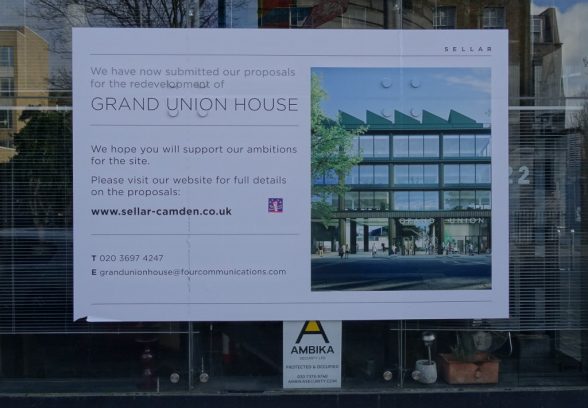This website uses cookies
This website uses cookies to enable it to function properly and to analyse how the website is used. Please click 'Close' to accept and continue using the website.





As the architectural profession applaud the presentation to Nicholas Grimshaw of the RIBA’s Royal Gold Medal, the highest honour for architecture in the UK, we announce an application to list his ground breaking Sainsbury’s Camden site, part of which is under threat of redevelopment.
Constructed in one phase between 1985 and 1988, the site consists of a Sainsbury’s superstore, a block of 11 terraced houses and 2 flats facing the Regent’s Canal, a commercial building housing flexible workshop studios called Grand Union House and a single storey nursery school building.
The aluminium cladding, which has become a signature of Grimshaw’s practice from this period, retained the industrial feel of the canal-side site making as strong an architectural statement as the nearby postmodern TVAM building designed by Grimshaw’s former partner Terry Farrell. The whole Sainsbury’s site was designed to follow the scale of neighbouring buildings, and the complex has been celebrated for capturing the essence of High-Tech architecture and successfully introducing the style into a busy urban environment without overpowering surrounding historic character.
An application has been submitted to strip Grand Union House down to the first floor slab and rebuild a four storey office block, and to infill the void fronting Kentish Town Road to provide small retail units. The former nursery school will be demolished and replaced with a four storey affordable housing with retail units at ground floor. The design is by Andrew Phillips architects.
The Grand Union House workshops are elevated above car parking and delivery access for articulated lorries. The light industrial class use of the building was dictated by the London Borough of Camden, who insisted that the former industrial use of the site be carried on in a portion of the new development. The façade facing Kentish Town Road uses the adaptable cladding system designed for the Herman Miller distribution building in Chippenham (1982). The remainder of the building is clad in aluminium panels, and the concrete frame at ground level is left exposed.
While we are not opposed to the concept of altering the layout of Grand Union House we are opposed to partial demolition which we feel would destroy the visual consistency across the elements of Grimshaw’s design.
In a letter objecting to the plans, C20 Society caseworker Grace Etherington says: “It is our view that the complexity of the site is a key aspect of the design’s success, and it pinpoints this development as one of the first mixed-use supermarket sites in an urban environment, notable for a time where the overwhelming majority of large chain stores were being built in out-of-town industrial estates. LB Camden’s insistence on a variety of uses within the site, Grimshaw’s use of new structural techniques in the supermarket building and the whole scheme’s striking aesthetic propelled the scheme to acclaim. We consider it vital that this aesthetic is retained across the site to reflect the architect’s skill in adapting industrial design techniques to fit a range of building types and functions in a challenging setting. “
In recent years there has been a growing recognition of Grimshaw’s extraordinary contribution to architectural culture in Britain, culminating in the award of the RIBA Royal Gold Medal. Grimshaw is considered to be one of the leading contributors to the British High-Tech movement which has earned international renown, and Historic England has described him as “one of the most prominent contemporary architects in England”. Grimshaw held the position of President of the Royal Academy of Arts between 2004 and 2011. His Financial Times Printworks and Western Morning News Building are both listed at Grade II*.
We anticipate the number of listed High-Tech buildings will increase greatly in coming years, and rare examples of industrial design methods being adapted to urban settings and typologies will undoubtedly stand out as worthy of protection and celebration.
The Sainsbury’s complex was widely praised in both the architectural and mainstream press as a pioneering retail development located in an urban setting. Martin Pawley in the Guardian described the scheme as “the most extraordinary piece of take-no-prisoners advanced technology architecture since the Lloyd’s building.”
We have submitted an application to Historic England to list the whole Sainsbury’s site at Grade II and are urging LB Camden to wait for a decision on this before determining the redevelopment plans that will impact the site’s architectural and historic interest.
We are also chasing a decision from Historic England on our application in 2016 to list at Grade II* the Waterloo International Terminal, which Grimshaw has described as his greatest and most challenging building. Although the application had been for urgent spot listing, the Network Rail upgrade work had already started with the stripping out of the underground arrival and departure lounges. Much to our disappointment, HE said it would delay a decision until the upgrade had been completed.
At an event at the RIBA last Wednesday (13 February) to celebrate the awarding of the Royal Gold Medal to Nicholas Grimshaw, RIBA Journal Editor Hugh Pearman highlighted our Waterloo listing application and asked the audience of about 400 to vote by a show of hands on whether Waterloo International should be giving listing protection. A resounding 98 per cent were in favour. We hope HE endorses this view and that the Sainsbury’s site also joins his ever growing list of protected buildings.

Become a C20 member today and help save our modern design heritage.